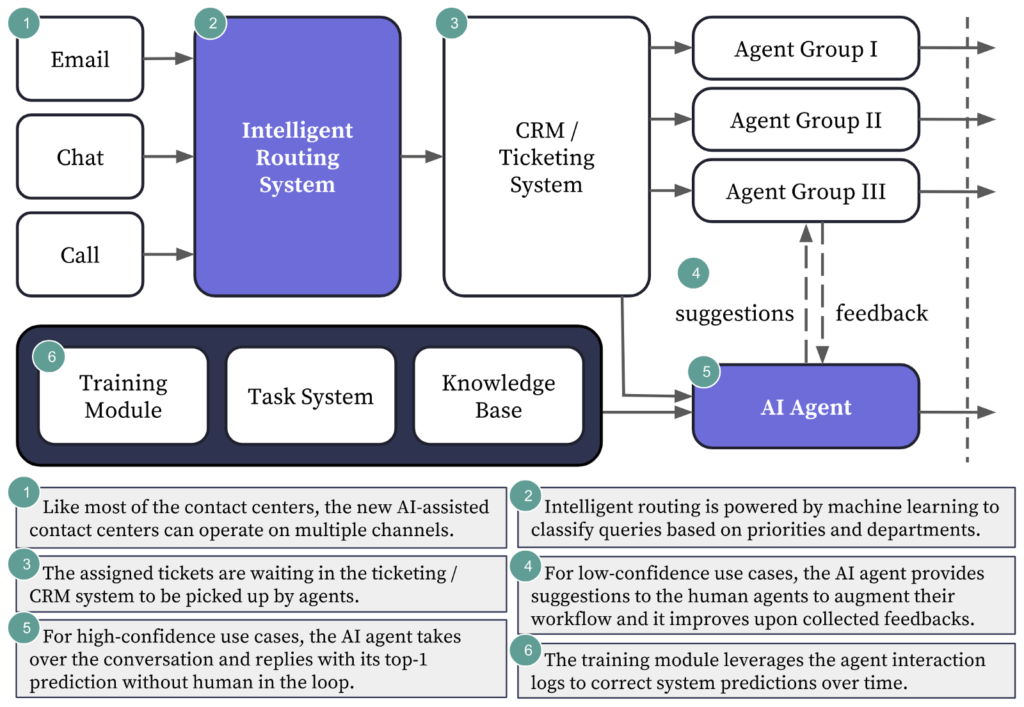There is a growing need for customer support automation using the latest AI technology, and it has the potential to completely change the industry landscape. The following roadmap outlines how PolyAI plans to achieve the ambition through step-by-step milestones, which also provide insights to contact center owners on how technology can be leveraged to transform their businesses.
Service automation has been at the forefront of the recent technology revolution inspired by Artificial Intelligence and greatly reshaped the way businesses operate. For example, businesses are now utilizing robots to run large warehouses, leveraging smart routing to enable expeditious next-day delivery, and providing better insurance and loan policies using large-scale data mining. Customer service is the next frontier for AI-supported technology. According to recent estimates from digital market moguls “by 2020, 85% of all customer interactions will be handled without a human agent”.
Customer service is a $200bn+ market globally, and it is worth $60bn+ in US and UK alone. There are 6 million people working in 40,000 US call centers today, while in the UK, customer service workers take up to 2% of the population. Every call made to Tesco, BT, etc. is likely routed to a department of hundreds, if not, thousands of call center agents. Problems plaguing the industry are labor-intensive, heavy employee churn, and low margins — which leaves a lot of space for new technologies to really make a difference.
The excitement surrounding the potential of AI-powered technology to revolutionize the contact center industry originates from recent leaps in machine learning and natural language processing. The former enables machines to learn patterns from millions of data points without predefined rules, while the latter allows computers to understand and interpret human language with all its nuances. The latest technology holds promise to support automated contact centre agents that can understand user intents more accurately and act more naturally. However, despite the technological progress, a quick reality check indicates that there is still a huge gap between the long-term promises and the current state of affairs. In other words, we are still far from building automated conversational AI that fully reach users’ expectation. The chatbot failure is a funny, yet revealing example of the discrepancy between the potential and the reality. It exemplifies the necessity of more profound reflections on current conversational AI development and their deployment in the industry.
Despite the challenges, contact center automation powered by AI and machine learning is an ever-increasing trend. The imminent maturing of supporting technology will transform the contact center industry. For contact center owners, it is of utmost importance to recognize this trend and adapt to this emerging technology. Based on years of experience working with AI technologies complemented with understanding of the contact center landscape, the following roadmap provides a list of practical steps towards AI-driven contact centers.

Intelligent Call Routing and Ticket Assignment
Call routing has been the main focus of customer support automation, with Interactive Voice Response (IVR) as the representative technology. Efficiently routing a call to the right agent is crucial to a successful first contact resolution. As the technology evolves, automation of ticket assignment in cloud-based CRMs like Salesforce and Zendesk is still critical for contact center efficiency. From the technology perspective, intelligent call routing (i.e., smart routing) can be cast as a supervised classification problem in machine learning: this setting has been extensively studied, it is widely applied and ready for production. For contact center owners, this is a good entry point for probing automation technology since its KPI is easy to define and multiple gains in contact center efficiency can be expected with only a short-term investment.
AI-Assisted Auto-Suggestion
The natural follow-up to intelligent routing is AI-assisted auto-suggestion of agent responses. With our machine learning hats one, we can frame this as a fine-grained classification problem with a much larger number of classes than the smart routing task. The increase in the number of classes naturally implies a more difficult classification problem. Therefore, it is necessary for the machine learning system to listen to conversations and learn from human agents at this stage. An auto-suggestion framework is a natural choice here. For contact center owners, it completely mitigates the risk of direct automation disrupting user satisfaction while enabling human agents to become more productive over time.
Automating First-Contact Resolution
Relying on the power of machine learning and the auto-suggestion framework, the system continuously learns to improve on its ability to predict agent responses. This will enable contact centers to slowly start experimenting with automation of first-contact resolution. Automating customer service at this first step has a massive value for both user satisfaction (imagine no more 30+ minute wait times for basic requests) and contact center efficiency. What is more, automating first contact resolution is way easier than full conversation automation. It bypasses the requirement to understand full conversational context, which is still the paramount issue of conversational AI.
The Final Frontier: Complex Customer Support Automation
The goal of the final customer service automation stage is to take human agents out of the loop for some use cases, and let machines to take over complete conversations in contact centers. However, the current technology is still not sufficiently developed to support this level of automation at a production scale. This feat requires further developments in the core automated conversational agent design. For instance, several open questions concern the effective continuous resolution of dialogue context, and the ability to detect when to hand off a more complex conversation to a human agent.
Conclusion
In summary, customer support automation underpinned by machine learning and AI technology is an inevitable trend offering unmatched potential. The new automation solutions will revolutionize the modus operandi of modern contact centers. However, integrating such cutting-edge AI-empowered solutions into existing contact centers requires deep understanding of the technology as well as customer service dynamics, as well as a carefully designed plan and diligence. At PolyAI, we are working toward this mission, aiming at making contact centers more efficient through our conversational AI platform and vertical integration. The presented roadmap outlines our internal step-by-step milestones, which also provide insights to contact center owners on how technology can be leveraged to transform their businesses.
As our team at PolyAI learns more about the day-to-day operations of contact centers, we continue to identify creative ways technology can be used to unlock greater performance and efficiency for the industry. We are excited to begin this journey and provide our findings and lessons with you all along the way — stay tuned!




